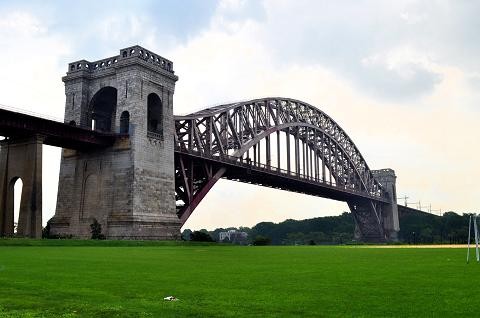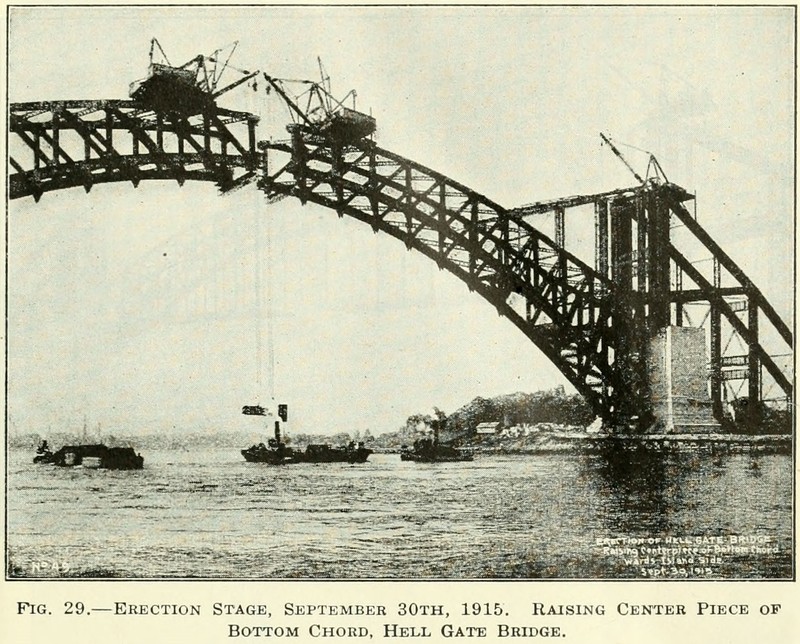Hell Gate Bridge
Introduction
Text-to-speech Audio
Completed in 1917, Hell Gate Bridge allowed for rail traffic across the East River in New York City, connecting Astoria Park to Ward's Island. The bridge is official named the New York Connecting Railroad Bridge, although its original moniker is used more often by locals. The Dutch were the first Europeans to explore and settle in this area, and the name "Hell Gate" is a variation of the original Dutch word "hellegat" which referred to a narrow strait. The bridge underwent construction beginning in 1912 and was finished in 1917. When the bridge was completed, it was the longest steel arch bridge in the world. Hell Gate Bridge has a rich history that includes secret plans by Nazis to destroy the bridge to local stories of mysterious events. The bridge is still in use today.
Images
Hell Gate Bridge (2012)

Construction of Hell Gate Bridge (1915)

Backstory and Context
Text-to-speech Audio
Hell Gate Bridge is a series of three railroad bridges that run over the East River in New York City. Construction of the Bridge began 1912 when New Yorkers needed quicker passage from Astoria to the Bronx. The Bridge was completed in 1917, running from 50th Street in Brooklyn to 141st Street in the Bronx. It is over three and a half miles long, which made it the longest steel arch bridge in the world when it was first constructed.
The Bridge was part of a project by the Pennsylvania Railroad which sought to connect New York to the rest of New England. It was designed by Oliver Barnes and Gustav Lindenthal. Lindenthal was already part of other bridge building projects which included the Williamsburg Bridge, the Manhattan Bridge, and the Queensboro Bridge. He had hoped to be part of a project that built a suspension bridge over the Hudson River, but he was never provided the opportunity as the city decided to use tunnels instead of a bridge. Since Lindanthal was largely in charge of the Hell Gate Bridge design, he decided to hire other engineers to focus on the support system and weight distribution aspects of the Bridge, while he focused on the aesthetic quality.
The first train, a Federal Express using the Pennsylvania Railroad, passed over the Bridge on March 9, 1917. This would complete the first nonstop rail service from Washington D.C. to Boston. The Bridge is still used today though less frequently since passenger cars have been replaced by automobiles. It is still structurally sound as well, with some engineers saying it could outlast the human race. Since the Bridge was covered in graffiti, the City provided money in 1991 to have the Bridge painted. They choose the color red, and the project was finished in 1996.
The Bridge was part of a project by the Pennsylvania Railroad which sought to connect New York to the rest of New England. It was designed by Oliver Barnes and Gustav Lindenthal. Lindenthal was already part of other bridge building projects which included the Williamsburg Bridge, the Manhattan Bridge, and the Queensboro Bridge. He had hoped to be part of a project that built a suspension bridge over the Hudson River, but he was never provided the opportunity as the city decided to use tunnels instead of a bridge. Since Lindanthal was largely in charge of the Hell Gate Bridge design, he decided to hire other engineers to focus on the support system and weight distribution aspects of the Bridge, while he focused on the aesthetic quality.
The first train, a Federal Express using the Pennsylvania Railroad, passed over the Bridge on March 9, 1917. This would complete the first nonstop rail service from Washington D.C. to Boston. The Bridge is still used today though less frequently since passenger cars have been replaced by automobiles. It is still structurally sound as well, with some engineers saying it could outlast the human race. Since the Bridge was covered in graffiti, the City provided money in 1991 to have the Bridge painted. They choose the color red, and the project was finished in 1996.
Cite This Entry
Thagard, Gavin and Clio Admin. "Hell Gate Bridge." Clio: Your Guide to History. February 4, 2018. Accessed March 27, 2025. https://theclio.com/tour/2274/5
Sources
Holth, Nathan. "Hell Gate Bridge." HistoricBridges.org. 10/19/13. Accessed Web, 11/2/17. http://historicbridges.org/bridges/browser/?bridgebrowser=newyork/hellgatebridge/.
Healy, Ryan. "The Strange History Of NYC's Mighty Hell Gate." Gothamist. 2/22/16. Accessed Web, 11/2/17. http://gothamist.com/2016/02/22/hell_gate_history_nyc.php.
"Hell Gate Bridge." NYC Roads. AccessedWeb, 11/2/17. http://www.nycroads.com/crossings/hell-gate/.
Healy, Ryan. "The Strange History Of NYC's Mighty Hell Gate." Gothamist. 2/22/16. Accessed Web, 11/2/17. http://gothamist.com/2016/02/22/hell_gate_history_nyc.php.
"Hell Gate Bridge." NYC Roads. AccessedWeb, 11/2/17. http://www.nycroads.com/crossings/hell-gate/.

